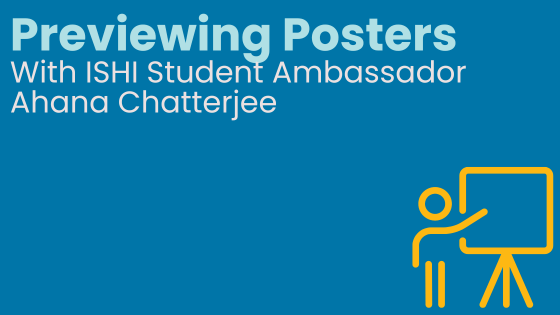The utility of trace DNA recovered from touched surfaces has been well studied in recent years. A combination of anucleated corneocytes, nucleated cells, and cell-free DNA deposited on touched surfaces can serve as sources of DNA on various substrates. Adhesive substrates, such as duct tape, electrical tape, hinge lifters, gel lifters, and Mikrosil® casting putty are routinely submitted for fingerprint examination in criminal investigations. Besides examining fingerprints developed on or lifted from nonporous surfaces using these adhesives, these substrates can be submitted for DNA analysis. ISHI Student Ambassador, Ahana Chatterjee’s study aims to evaluate the effectiveness of fingerprint lifters as reliable sources of trace DNA. Furthermore, this study aims to explore the use of next generation sequencing used for forensic investigative genetic genealogy (FIGG) applications on these sample types.
We chatted with Ahana to learn a little more, and if you’ll be at ISHI this September, be sure to stop by during the poster sessions to learn more!

Briefly describe your work/area of interest.
The study compares two distinct DNA recovery methods: direct lysis of the adhesive substrates and swabbing of fingerprint marks deposited on the adhesive surfaces. The effectiveness of both nylon and cotton swabs were evaluated using three different solvents: water, xylene, and lysis buffer. The aim of the research was to determine the most efficient and reliable approach for analyzing DNA from these sample types, considering factors such as DNA yield and ease of implementation. DNA extraction was performed using the EZ1 DNA Investigator Kit on the EZ1 Advanced XL system (QIAGEN). Samples were quantified using the Investigator Quantiplex Pro Kit followed by traditional STR typing using the Investigator 24plex QS Kit, to assess the quality and completeness of the DNA profiles obtained.
The collaborators in this project included Natalia Czado, Dr Rachel Houston and Dr Sheree Hughes.
Results demonstrated a clear advantage for the direct lysis of duct tape, electrical tape, and hinge lifters samples, with a 100% allele recovery rate. In contrast, for gel lifters and Mikrosil, the combination of swabbing using cotton swabs moistened with lysis buffer proved to be more effective, with an average allele recovery of 87.9% for gel lifters and 88.6% for Mikrosil.
How did you become interested in this work? Why did this particular project appeal?
This project grabbed my attention because it was totally different from anything I’d done before. I was excited to see where it would lead. One of the examples that came up when the project was first introduced was a kidnapping case where duct tape was used to tie up the victim. Naturally, there might be fingerprints on the duct tape, but then the big questions hit me: Could we actually get DNA from that? If so, how much? And what’s the best way to collect it? These questions got me hooked, and I knew I had to dive into this project to find out the answers.
What has been the most rewarding part of working on this project?
The most rewarding part of the project was looking at the allele recovery. It was a classic example of less is more. I was fascinated as to how a very low amount of DNA was enough to produce a complete DNA profile.
Are there any further areas of research you think are needed based on your findings?
In the future, a subset of samples will be sequenced using the ForenSeq Kintelligence Kit to assess whether these sample types can serve as probative samples for FIGG purposes.
How do you hope your research will be applied in real-world scenarios?
The findings of this study have significant implications for forensic practices, suggesting that the choice of DNA collection method should be tailored to the specific type of adhesive material. Moreover, the high recovery rates achieved through direct lysis and optimized swabbing techniques enhance the potential for successful DNA profiling from challenging forensic samples. Future research using Kintelligence will explore whether integrating STR typing with FIGG can provide more comprehensive and informative leads in forensic casework, potentially solving more complex cases.

